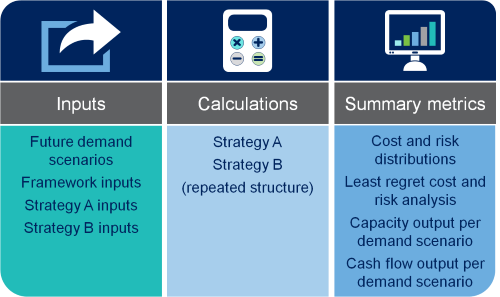Real options model
Real options model
The Demand Scenarios Network Innovation Allowance (NIA) project has developed a prototype tool to support decisions about when to use our post-fault demand side management (DSM) technique as an alternative or in combination with traditional network reinforcement. The tool presents a variety of cost and risk metrics to compare the intervention strategies. This is a ‘real options’ approach to decision-making, which recognises uncertainty in future demand and flexibility in potential investments.
This work supports the transition to business-as-usual of the demand side management technique developed in our Capacity to Customers project (now known as 'Managed Connections').
Real options model

The initial work on developing the real options approach was done under a forerunner Innovation Funding Incentive (IFI) project ‘Demand Forecasts and Real Options’ with academics from the University of Manchester. The scoping report on approach can be found below. A peer-reviewed journal paper based on a 2015 academic version of the real options model can be found below.
Within the Demand Scenarios NIA project, the prototype has been further adapted and developed for business use by ourselves. Our Real Options Cost Benefit Analysis (RO-CBA) tool can use the peak demand scenarios per substation which were developed in the NIA project. The tool is designed to consider specific investment projects at the grid and primary level, reflecting approval processes for capital projects, but may be used in future to set overall policy. Using a real-options approach with the improved demand scenarios helps ensure that load-related investment is well-justified from a regulatory and business perspective, and in particular will enable us to identify when a demand-side-response technique should be used to avoid or defer a traditional investment in capacity.
Work on the prototype is now complete and is being integrated routinely into business as usual processes; during the project it was used to justify signing one managed connection as an alternative to an expensive traditional reinforcement.
A presentation on the prototype model was given in June 2016 at the International Centre for Mathematical Sciences in a conference on ‘Energy Management: Flexibility, Risk and Optimisation’.